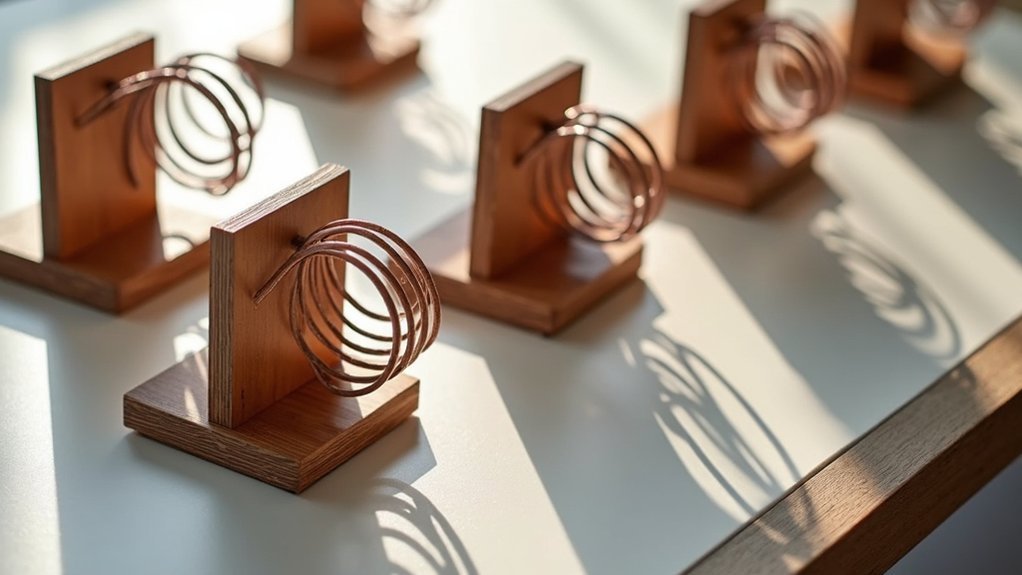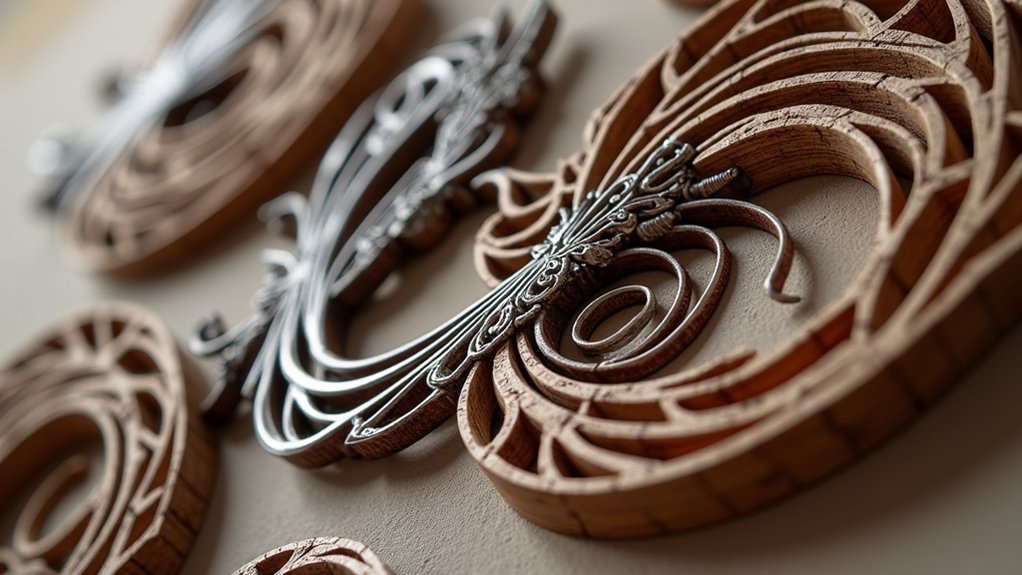You can create architectural model buildings with wooden bases and metal frameworks that blend organic warmth with industrial precision. Designer jewelry pieces combine wood grain textures with metallic accents for striking visual contrast. Functional desktop organizers feature wood panels paired with sturdy metal dividers for both beauty and practicality. Decorative wall art merges wood’s natural appeal with geometric metal patterns. Custom phone cases showcase smooth wood-metal gradient effects that demonstrate advanced printing techniques and material shifts.
Architectural Model Buildings With Wood Base and Metal Frameworks

When you’re designing architectural models, wood-metal filament combinations offer an exceptional way to capture both the organic warmth of timber and the industrial precision of steel frameworks.
You’ll find LAYWOO-D3 filament creates an authentic wooden base that’s both sustainable and eco-friendly, reducing plastic waste while maintaining traditional wood appeal.
For metal components, you can use advanced hybrid filaments that blend metal powder with polymer, enabling intricate designs with robust structural support.
These materials let you experiment with innovative forms and complex geometries that showcase 3D printing’s versatility.
You’ll enhance realism through post-processing techniques like sanding and staining wooden parts, while painting or polishing metal elements creates visually striking representations of real structures.
Designer Jewelry Featuring Wood Grain and Metallic Accents
Three distinct advantages make wood-metal filament combinations perfect for creating designer jewelry that captures both natural beauty and contemporary sophistication.
You’ll create pieces that showcase wood’s organic texture alongside metal’s sleek finish, producing visually striking contrasts that elevate any accessory. The versatility lets you customize designs from contemporary minimalist rings to traditional ornate pendants, accommodating diverse personal tastes and occasions.
You’re also supporting sustainable fashion trends by choosing eco-friendly wood components, appealing to environmentally conscious consumers who won’t compromise on style.
Eco-conscious jewelry lovers can embrace sustainable wood components without sacrificing the sophisticated style they desire in modern accessories.
Through layering techniques and post-processing methods, you can add detailed engravings and polished finishes that emphasize the dynamic interplay between materials. This combination allows intricate designs that highlight each material’s unique properties while creating cohesive, elegant pieces.
Functional Desktop Organizers With Wood Panels and Metal Dividers

Moving beyond wearable accessories, wood-metal filament combinations excel at creating functional desktop organizers that transform cluttered workspaces into efficient, aesthetically pleasing environments.
You’ll find that LAYWOO-D3 wood filament delivers authentic wood grain textures that bring warmth to your office setup, while metal dividers provide essential structural stability for heavier items like books and files.
These customizable organizers let you tailor dimensions and layouts to your specific needs:
- Adjustable compartment sizes for various office supplies
- Removable metal dividers for flexible configurations
- Stackable modules that grow with your storage requirements
- Integrated cable management slots for clean wire routing
Post-processing techniques like sanding and staining enhance the wood panels’ appearance, creating polished organizers that complement any interior design style.
Decorative Wall Art Combining Wood Textures and Metal Geometric Patterns
Why settle for traditional wall art when you can create stunning pieces that merge wood’s organic warmth with metal’s precise geometric beauty?
You’ll achieve this striking contrast using wood-based filaments like LAYWOO-D3 alongside metal-infused options, creating intricate designs that showcase both organic and industrial elements.
Your finished pieces won’t just look impressive—they’ll also offer enhanced durability suitable for homes and commercial spaces.
These hybrid creations deliver exceptional longevity and visual impact, making them perfect for both residential interiors and high-traffic commercial environments.
You can elevate quality through post-processing: sand and stain wood components while polishing metal aspects for professional results.
Consider incorporating LED lighting elements to create dynamic displays that enhance light-shadow interplay, showcasing each material’s unique textures.
This combination transforms ordinary walls into conversation pieces that blend natural warmth with sleek metallic sophistication.
Custom Phone Cases With Wood-Metal Gradient Effects

Custom phone cases offer the perfect canvas for experimenting with wood-metal gradient effects that transform everyday accessories into personalized statement pieces.
You’ll create stunning shifts by blending wood fibers with metallic particles, achieving smooth gradients through strategic print settings and layering techniques. The wood-metal filament replicates natural wood texture while incorporating sleek metallic finishes, providing enhanced grip and visual appeal.
Here are key techniques for best results:
- Adjust print temperatures gradually during the process to create seamless color shifts.
- Use variable layer heights to enhance texture definition between wood and metal sections.
- Apply post-processing methods like sanding and staining for improved durability.
- Design gradient patterns that complement your phone’s natural curves and button placements.
You’re promoting sustainability while reducing plastic waste through eco-friendly materials.
Frequently Asked Questions
What Is the Best Print Setting for Wood Filament?
You’ll want to set your temperature between 190-220°C, use 30-50 mm/s print speed, choose a 0.4-0.5mm nozzle, set 0.1-0.3mm layer height, and enable cooling fans for ideal results.
What Is the Most Profitable Thing to 3D Print?
You’ll find custom furniture offers the highest profits when 3D printing. Consumers pay premium prices for personalized designs and craftsmanship. Artistic sculptures and functional prototypes also generate substantial returns through specialized services.
Is There Anything Illegal to 3D Print?
You can’t legally 3D print firearms, counterfeit items, copyrighted designs, or hazardous medical devices without proper licenses. You’ll face serious legal consequences including lawsuits and criminal charges for violating these restrictions.
Why Is TPU so Hard to Print With?
You’ll struggle with TPU because it’s flexible, causing filament jams and inconsistent extrusion. You need slower speeds, precise retraction settings, heated beds, and careful calibration to prevent warping, stringing, and degradation.





Leave a Reply